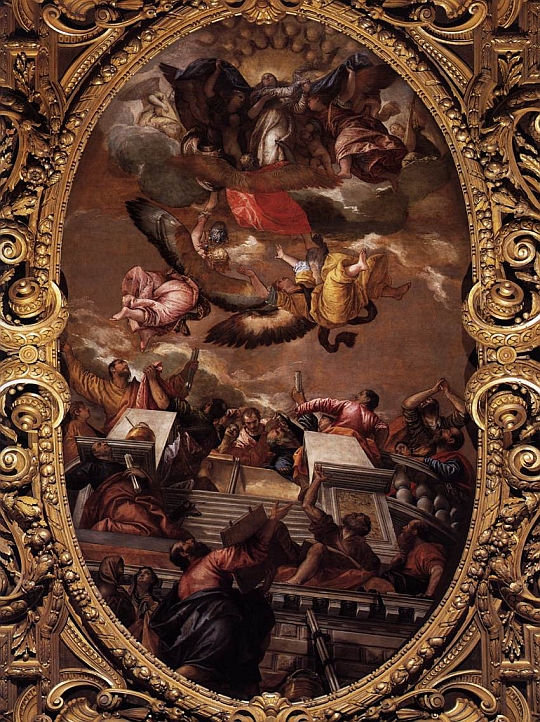
Poi che spiegat’ho l’ali al bel desio,
quanto più sott’il piè l’aria mi scorgo,
più le veloci penne al vento porgo:
e spreggio il mondo, e vers’il ciel m’invio.
Né del figliuol di Dedalo il fin rio
fa che giù pieghi, anzi via più risorgo;
ch’i’ cadrò morto a terra ben m’accorgo:
ma qual vita pareggia al morir mio?
La voce del mio cor per l’aria sento:
“Ove mi porti, temerario? china,
che raro è senza duol tropp’ardimento”;
“Non temer,” respond’io, “l’alta ruina.
Fendi sicur le nubi, e muor contento:
s’il ciel sì illustre morte ne destina”.
Now that I have given wings to that beautiful Desire,
The more I see the air under my feet,
The more I set my speedy feathers to the wind,
With contempt for the world, I move towards the Heavens.
Nor does the cruel plight of Daedalus’s son
Bring me down; in fact, I climb higher,
Knowing with certainty that in the end I shall fall dead to earth:
But what life bears measure to this death?
The air rings with the voice of my heart:
“Where do you take me, fearful one? Bow down,
For rarely does great ardor go unaccompanied by pain;”
“Do not fear ruin on high,” I answer,
“Part the clouds with certainty and die content:
If the heavens portend us a death so illustrious.”
—Luigi Tansillo, Sonetto II: Poi che spiegat’ho (ca. 1550) in Poesie liriche edite ed inedite di Luigi Tansillo, pp. 214-17 (F. Fiorentino ed. 1888) (S.H. transl., another translation, by Lorna de’ Lucchi, can be found here) quoted by Giordano Bruno in Argomento del nolano sopra gli eroici furiosi (1585)
This sonnet, of which Giordano Bruno was so fond, ably expresses core thoughts of the humanist revival that marked the Italian Renaissance. Man is portrayed with a new spatial focus–the two-dimensional hierarchical conception of the medieval era fades away in favor of a man of Promethian aspirations, committed to a search for improvement of his self and his society while literally probing the limits of human knowledge with an inquiry into the celestial mechanics. It parallels the changes in the art world in which new spatial relationships also arise from a study of perspectives, some of them, like Veronese’s Assumption, dizzying and majestic both. The theme of a thrust towards heaven comes to dominate. One spirit gives us Bruno, Veronese, da Vinci and Copernicus, Gallileo and Kepler. Key to understanding Bruno, Tansillo and others of this period is thus the relationship of human beings as individuals to the universe–it has been ripped free from the highly restrained notions of the Gothic period in which a series of dogmas had been placed in the way of free intellectual inquiry. But for Tansillo it is the willingness to dare that matters, the determination to pursue the possible in the face of the limitations of the physical and the certainty of death.
Tansillo’s sonnet, Bruno’s dialogues and writings stand in close proximity to one of the most intriguing historical events of the era, so many ways typical of it through its combination of the brutal, conniving facts of life with the transcendent possibilities of the human spirit. On October 19, 1587, Francesco de’ Medici and his wife Bianco Cappello were mysteriously murdered on one of their Tuscan estates. Ferdinando de’ Medici then seized power in Tuscany. Particularly as he was suspected from the start of involvement in the double murder, Ferdinando was eager to reinforce the Medici alliance with France by marrying a daughter of the French royal house. The wedding celebration, in May 1589, was one of the great events of the high Renaissance. Accounts reflect that works of Tansillo and Bruno were read and presented, but the high point was the performance of La Pellegrina (The Pilgrimess), a collage of six shorter pieces (intermedii) which were the joint work of a number of artists associated with the Medici court using a libretto by Girolamo Bargagli but with many texts supplied by Ottavio Rinuccini, under the overall artistic direction of Cristofano Malvezzi. The production was, according to contemporary accounts, tempestuous. Artists bitterly assailed and criticized one another in what turned into a furious struggle for the favor of one of Europe’s greatest patrons. Notwithstanding these circumstances (or perhaps because of them), the work was an immediate cultural sensation, and its fame quickly spread throughout Italy and on to other European courts. The content of Pellegrina fluctuates between the Neoplatonic, such as the first tableau’s portrait of the Pythagorean theory of the Harmony of the Spheres (L’Armonia delle spere) to the allegorical, including a series of scenes from mythology chosen to reflect a suspicious refrain of Bruno’s La spaccio della bestia trionfante. Looking back for the roots of the modern opera it now seems clear: it was born in that remarkable wedding celebration in Florence in 1589. Rinuccini, in fact, went on to supply the libretti for several of the operatic works of Claudio Monteverdi, as well as Jacopo Corsi and Jacopo Peri’s Daphne, usually reckoned the first proper opera.
Listen to La Pellegrina in a Sony recording of a performance by Paul van Nevel and the Huelgas Ensemble. If you want to pick just one piece from this marvelous confection, let it be the concluding ballo from Intermedio VI, O che nuovo miracolo by Emilio de’ Cavalieri.
Listen to Orlando di Lasso’s setting (1594) of the 21st motet from Tansillo’s Lagrime di San Pietro, Vide homo, quae pro te patior, in a performance by the Ensemble Vocal Européen directed by Philippe Herreweghe (with a not-quite literal, but quite to the point translation of the text):



